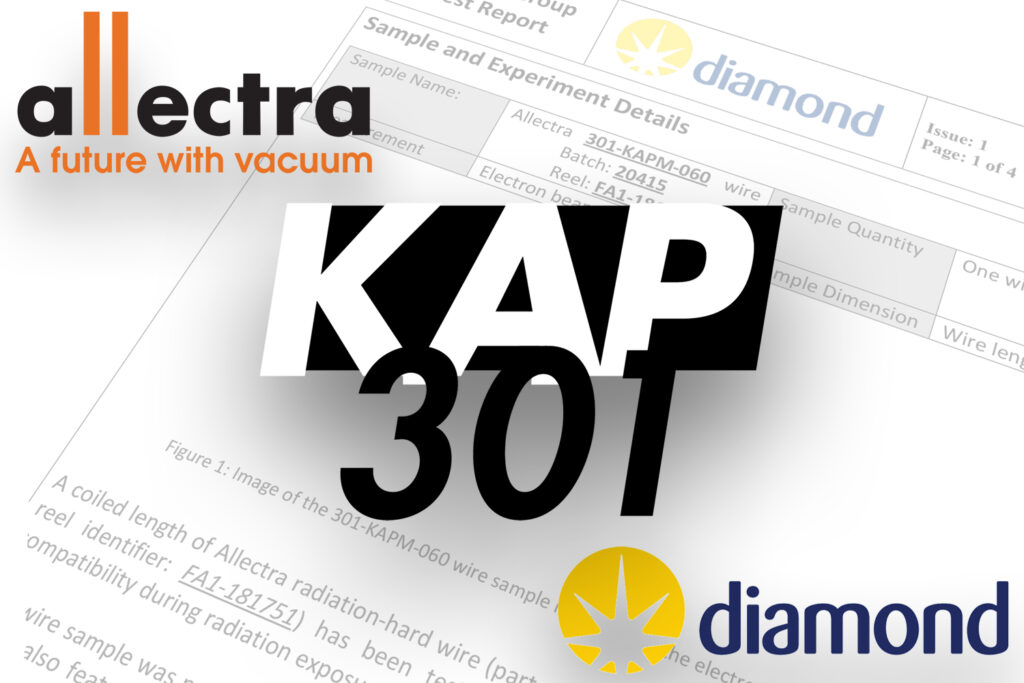Modern particle accelerators such as the Large Hadron Collider at CERN let particles smash into each other at a speed close to the speed of light and at energy densities far higher than inside a super-nova explosion of a star. Some, including the electron storage ring of the Diamond Light Source in the UK, let electrons circle for millions of kilometres close to the speed of light, making the electrons emit bright x-ray radiation for science experiments. Those are, obviously, rather extreme conditions, and you most certainly don’t want any random gas molecule standing in the way of your speeding particles. Enter Ultra-High-Vacuum (UHV). UHV is a fancy way of saying “the emptiest emptiness that we can achieve”. It is a surprisingly challenging task, as engineers and researchers from the field will agree.
A typical UHV level in particle accelerators is 10-10 mbar. How empty is that? At 10-10 mbar, you have 1 gas molecule in a volume equivalent to a small sand grain (SSG volume).(1) That’s a vacuum almost as rarefied as that found on the surface of the Moon.(2) As contrast, consider the air that you breathe just now. There are 10,000,000,000,000 gas molecules in a SSG volume.(3)
That is not only a huge quantitative difference, but also a qualitative one. At atmospheric pressure, gas molecules are constantly bumping into each other with mean free path length of just about 0.1µm between each bump.(4) At 10-10 mbar with a mean free path length of about 1000 km, the gas the molecules make journeys in solitude from one vacuum wall to another or sometimes into the pump.
As a UHV engineer, outgassing of material inside your vacuum is a constant antagonist. Let’s consider a piece of a particle accelerator beam pipe of 50mm inner diameter. If the pipe is made of austenitic stainless steel, that pipe will, unbaked (5) (6), emit about 1,000 gas molecules per second per SSG volume after 10h of pumping.(7) If the inner pipe was fully cladded with silicone (8) (not recommended), it would outgas 10,000 times as much, that is, 10,000,000 gas molecules per second per SSG volume after 10h of pumping. Remember that you can only tolerate 1 gas molecule per SSG volume. That’s part of the challenge of UHV. You need strong vacuum pumps. You also need the right materials. In particle accelerators you have the additional challenge of radiation. A high-energy particle may hit your material, damage it, and contaminate your vacuum with some of the material’s atoms. In a radiative environment, if you don’t want Chlorine or Fluorine atoms in your apparatus, you cannot use common, halogen-containing polymers, such as PTFE.
These are challenges our engineers at Allectra love obsessing about. In 2018, Allectra introduced KAP301, a radiation resistant, UHV compatible wire with optimized Kapton insulation. The insulation film has excellent outgassing properties and consists only of H, C, N, and O atoms. It is specifically designed for use in particle accelerators and other applications with high radiation levels. Read more about KAP301 and detailed qualification tests at the Diamond Light Source in the links below.(9)(10)
Whether you are researching elementary particles or working on the next industrial breakthrough, be sure to check-out Allectra’s wide range of UHV components on our web site. We know that every R&D project is unique and has unique requirements so get in touch and our technical sales experts will work with you to find a unique solution. At Allectra, we are proud to provide UHV components to the world’s largest particle accelerators. With components passionately engineered by Allectra, researchers can concentrate on what they love most: amazing science.
(1) I assume a grain of very fine sand, a spherical volume with diameter d=0.0918mm. That is close to the smallest grain that the United States Geological Survey still identifies as “sand”, cf. https://pubs.usgs.gov/of/2003/of03-001/htmldocs/images/chart.pdf
Together with ideal gas law: N = P V / (kB T) = 10-10 mbar (π/6) (0.0918mm)3 / (kB 293.2K) ≈ 1
(2) https://home.cern/science/engineering/vacuum-empty-interstellar-space
(3) N = P V / (kB T) = 1013mbar (π/6) (0.0918mm)3 / (kB 293.2K) ≈ 10,000,000,000,000
(4) LMFP = (kB T) / (p · √2 · π · dm2), cf. https://www.pfeiffer-vacuum.com/en/know-how/introduction-to-vacuum-technology/fundamentals/mean-free-path/
(5) Chiggiato, Paolo. “Outgassing properties of vacuum materials for particle accelerators.”, Proceedings of the 2017 CERN–Accelerator–School course on Vacuum for Particle Accelerators, Glumslöv, (Sweden), pp. 143–189, https://cas.web.cern.ch/previous-schools
(6) q = 3×10-10 (mbar · L) / (s · cm2) (Table 3 in [4])
(7) ΔN/Δt = q / (kB T) * π 50mm / (π (50mm)2 / SSGvolume) ≈ 1,000 /s
(8) q ≈ 3×10-6 (mbar · L) / (s · cm2) (Fig. 29 in [4]) ΔN/Δt ≈ 10,000,000 /s
(9) https://www.allectra.com/product-development-allectra/#radiation-resistant-kapton
(10) https://www.allectra.com/news/diamond-light-source-test-kap301-series/

